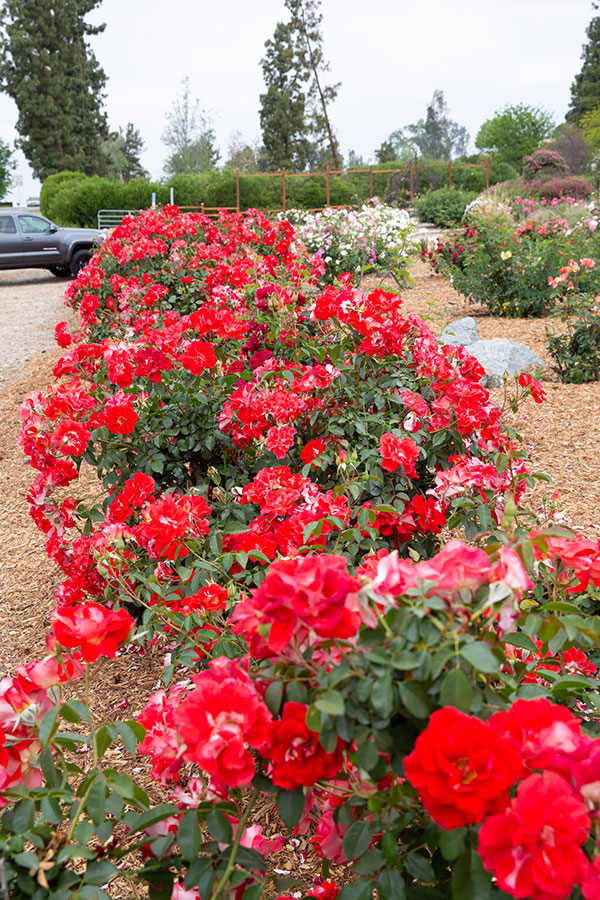Frank Brines, March 2022
Rose Care FUNdamentals – March 2022

Frank Brines
ARS Master Rosarian
Boy, has it been crazy weather? Depending on your location—or more specifically, that of your garden—you may have experienced frost damage to your roses and tender young plants recently. Keep an eye on your roses: If you see that frost has actually killed new growth that came out after pruning, you may need to re-prune, making your cuts just above the next outward-facing bud down the cane.
The thing is, even gardens in the same general vicinity may have different effects due to their prevailing micro-climates. The next few days of March will be slightly above normal with predicted temperatures in mid 80s. Overall temperature predicted for March is near average. Roses enjoy this weather which encourages roses to jump into life. A regular schedule for irrigating should already have begun. Roses do love food and water for the best blooms. Rule of thumb when new growth is 2-3 inches long it is time to begin a fertilizing program.
Take time now to inspect and make any necessary repairs to your irrigation system. Drip systems are the most efficient and they avoid problems created by above-ground sprayers and sprinklers, which waste water and can foster molds (e.g., mildew and rust). If possible, avoid any over-spray or misting applied elsewhere in your garden that may hit your roses; but if you use overhead watering systems, avoid doing so when there is any wind to avoid moisture evaporating or collecting on leaves which could result is sun burn or add to conditions favorable for fugal diseases. For best results and efficiency, be sure to schedule irrigation so it is complete before the day gets hot (preferably by mid-morning, that is, 8am to 9am). Avoiding afternoon or evening watering prevents excess ground moisture into night time. Too wet soil can lead to unhappy roots and/or fungal diseases.
If your roses experienced fungal diseases last year and you haven’t yet done so, you might think of applying a lime sulfur dormant spray soon. You can mix Horticultural Oil with the dormant spray for better adherence. Read the label to make sure you can mix different sprays. As a note of future caution, be prepared for chilli thrips as temp warms up.
Steps to take when ready to spray: First, make sure the garden is free of left-over debris and to dispose it in the green garden waste bin—do NOT compost rose debris in your yard. Backyard composting doesn’t get hot enough kill any pathogens. Second, remove all old leaves that may be left on the bush. This cleanliness will help keep down disease. Third, read the spray label completely to ensure the proper strength of the mixture for “growing season instructions” as the new growth has begun. Fourth, saturate all canes and the soil surface of the entire bed. Fifth, maintain a minimum of 2″ to 4″ of organic composted mulch over the entire garden surface to insulate the upper 8″ to 12″ of the soil zone where most rose roots feed, and to reduce evaporation and conserve water, while still providing sufficient moisture. This will also supply nutrients to build the soil for your roses over the season.
You can begin fertilizing when new growth is 2″ to 3″ long. I suggest an initial feeding each year be higher in nitrogen (N) to encourage new stem and leaf growth. In about two weeks, apply fertilizer that is higher in phosphate (P) and potassium (K) to give roots a boost at start of season. New information suggests that continued use of fertilizer higher in P and K will foster greater root development and lead to better growth, disease resistance and healthier plants. Look for fertilizers rated as 8-10-8 that include micro elements for greater results.
I highly recommend organic type fertilizers vs. inorganic or “chemical” ones. Organics foster better soil development, a richer, livelier, more viable community of soil organisms that break the elements into easily absorbed form and release them slowly. They will “build” soil structure into a healthy component and when used regularly will develop a soil rich in reserve energy, allowing you to use less product with the same results.
If you have completed your pruning it is likely all your pruners need sharpened. Sharp pruners make for clean cuts and the prevention of diseases or otherwise damaged weak canes. The best files to use are thin flat types with diamond grit material. This type allows easier sharpening for the tight spaces between the cutting blade and bar. Attempt to follow the current/original bevel/angle of the sharp blade. Felco states that the angle for their pruners is 23 degrees. Keeping pruners clean can be done using 70% isopropyl alcohol,WD40 soak, or Lysol sheets. If heavy plant “juice” is a problem a small brass bristle brush will help remove it. Lubricate the mechanism with a light oil like 3-in-0ne.
There are rose shows scheduled for April 23 (at the Los Angeles Arboretum) and April 30 (San Diego Rose Society held in El Cajon).

Frank Brines
ARS Master Rosarian
I am an ARS Master Rosarian. If you would like personal answers to rose questions you can leave them on the TVRS website or email me at roseguy2000@aol.com.
